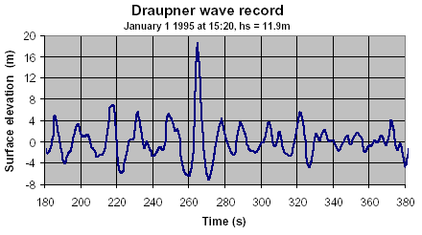Scientists Recreate 25-Year Old Freak Wave in a Laboratory for the First Time
On New Year's day, 1995, the Draupner oil rig off the coast of Norway was experiencing some rough weather. According to a wave log kept at the station, the rig was pounded by 40-foot waves for most of the day, but shortly after 3 PM a single 80-foot wave appeared out of nowhere and slammed into the rig at 45 miles per hour.
This rare natural phenomenon (of a sudden, large wave appearing unexpectedly) is known as a rogue or freak wave. Although they have been reported by sailors for centuries, until the Draupner rig was hit in 1995 there wasn't any evidence to support their existence. Over the past quarter-century a number of other freak waves have been documented, but scientists have been unable to explain how they form.
Now, a team of Oxford and the University of Edinburgh have recreated the Draupner freak wave in a laboratory for the first time and may finally be able to explain how they're created.
 Wave heights as measured at the Draupner oil rig on New Year's Day, 1995. Image: Wikimedia Commons
Wave heights as measured at the Draupner oil rig on New Year's Day, 1995. Image: Wikimedia CommonsAs detailed in a paper published in the February issue of the Journal of Fluid Mechanics, the Oxford and Edinburgh researchers found that freak waves are created when two smaller groups of waves intersect at just the right angle. To recreate the Draupner wave in the pool at the FlowWave Ocean Energy Research facility in Edinburgh, the researchers had the two wave groups intersect at 120 degrees.
Read More:Six-Storey Monster Wave Height Sets a New World Record
The waves created in the FlowWave center were much smaller than the waves actually registered at Draupner-the artificial waves broke at only a few feet. They were still considered freak waves, however, because of their relative height compared to the waves that produced them.
In other words, although the raw height of the wave was much smaller, the dynamics that produced them in the lab and the real world are the same.
The researchers hope that their laboratory work on freak waves will help oceanographers predict these rare natural occurrences in the future by analyzing wave patterns in the ocean.